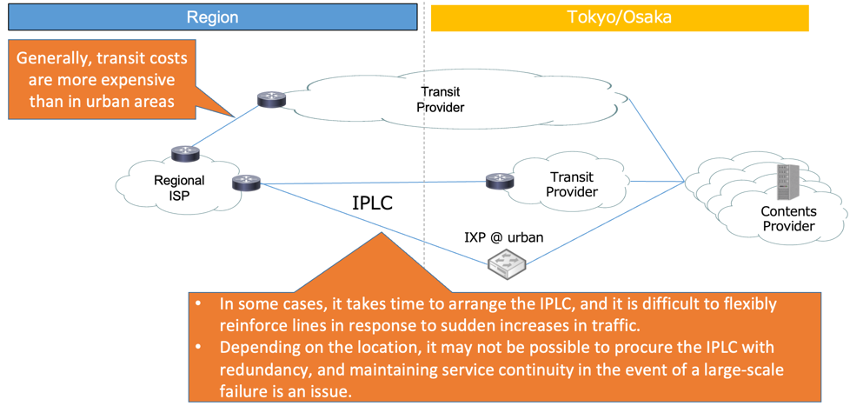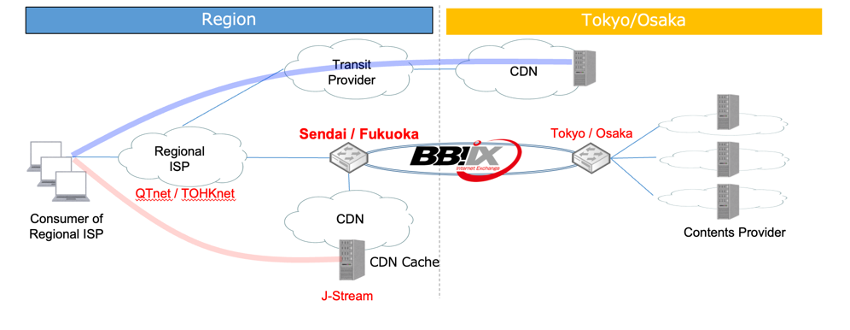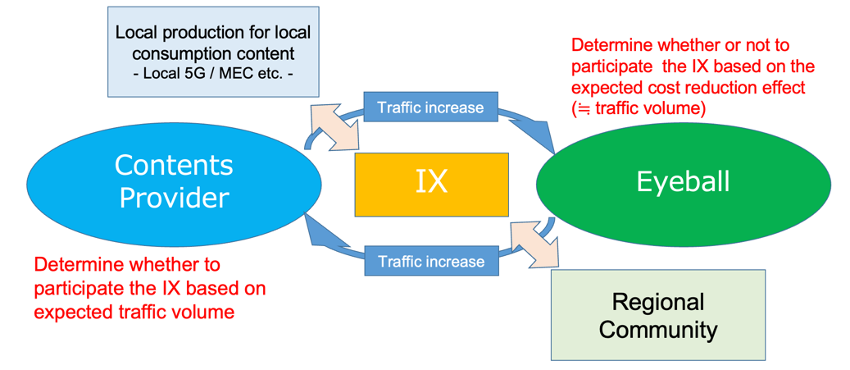
The challenge of bringing high-speed broadband Internet to regional areas outside of major cities is currently playing out in many economies, including Japan. While we are lucky to be smaller in land size than the USA or Australia, thus reducing the challenge of having to roll out millions of kilometres of cable, our regional users and ISPs still experience inferior bandwidth and lower return on investment than their city peers.
To improve the former of these challenges, the Ministry of Internal Affairs and Communications (MIC) commissioned a study in 2019 to verify whether it is possible to reduce costs and promote efficient traffic distribution by setting up traffic aggregation centres in regions outside of Japan’s main Internet gateways, Tokyo and Osaka. BBIX was one of two companies that were involved in the study; we were tasked with setting up two new regional Internet Exchanges (IXs) based in Sendai and Fukuoka, which we were able to show improved return-trip time (RTT) up to 87% (around 15ms).
In this post I want to provide some context on Japan’s Internet network, how we conducted the experiment and our outcomes, which we hope will assist with improving high-speed broadband connectivity in regional areas throughout Japan.
The Internet landscape in Japan
The Internet in Japan has two major convergence points: Tokyo, the capital, and Osaka, the centre of western Japan. Almost all major Internet Exchange Points (IXPs) and transit providers provide their services from these two central locations.
IXPs allow Internet Service Providers (ISPs) to extend their networks by exchanging routing information and traffic with other ISPs via a local exchange rather than needing to exchange local Internet traffic overseas. They have grown to play an important role in transiting local traffic, with studies showing they have a clear impact in reducing average AS-level path-lengths.
ISPs based outside of Tokyo and Osaka mainly use the following methods to secure upstream Internet connectivity:
- Purchasing transit in the region from a transit provider based in Tokyo/Osaka.
- Rent a leased line to Tokyo/Osaka and connect to the transit provider or IXP.

Arranging transit and leased lines from distant locations can be problematic due to long turnaround times and high costs. Also, in some regional areas, there is only one service provider, and it is not possible to ensure fault tolerance through redundancy.
In addition, the number of residential broadband customers is almost saturated in Japan. This makes it difficult for ISPs to expect a significant increase in the number of users and resulting increase in sales. This combination of factors has put regional ISPs in a very difficult situation.
Configuration of the experiment
In collaboration with J-Stream, QTnet and TOHKnet, BBIX set up new regional IXs for this study, based in Sendai and Fukuoka.

The IX we set up in Sendai had the same segment as in Tokyo and the one in Fukuoka had the same segment as in Osaka. This may seem strange as it is different from the purpose of the experiment — to improve Internet connectivity in the region. However, the growth of IXs is a chicken-and-egg problem where eyeball and content providers need each other. By having the same segment as the city centres, where major content providers (CDNs) are already connected, we would be able to see the benefits of what a fully connected IXP could offer without having to go through the process of signing these CDNs up.

Regional IXPs can provide significant improvement to connectivity
To understand if regional IXPs can make a difference to connectivity in these areas, we measured RTT and the quality of video downloads.
We measured a significant improvement in RTT between the regional and city-centre content servers — up to 87% / around 15ms — in both Sendai and Fukuoka.
For downloadable video content material, we observed an improvement in content download time of up to 37%. This suggests that delivering content from a location closer to the user can have a significant impact on the increased traffic associated with large online game updates, which is currently a challenge for many eyeball players.
Read: Land of the rising (regional) IXP
These findings provide us with a basic but important outlook of how regional IXPs can play a role to improve bandwidth in regional areas and assist local ISPs return on investment by bringing content closer to its users. Further, such IXPs can assist future technologies that require lower latency and higher bandwidth, such as local 5G and multi-access edge computing.
Satoru Tsurumaki is BBIX’s Director of Product Strategy. He is also a member of the Japan Open Policy Forum Steering Team.
The views expressed by the authors of this blog are their own and do not necessarily reflect the views of APNIC. Please note a Code of Conduct applies to this blog.

Very nice post, thanks Satoru.
These are important issues and very significant findings. I wonder if you might share more details, in future blog posts, or maybe a presentation at APRICOT 2022?
Thanks very much!
I second Paul Wilson’s comment and suggestion! Thank you, Satoru for a very insightful post! The issues are more important for Australia, as you had rightly identified. I am very keen to hear more from you on this important topic.
Thanks a lot!
This is today’s most pressing issue. Many other areas are having this issue as well. Thank you for sharing this post, and I’m looking forward to reading the other articles you’ll be providing.